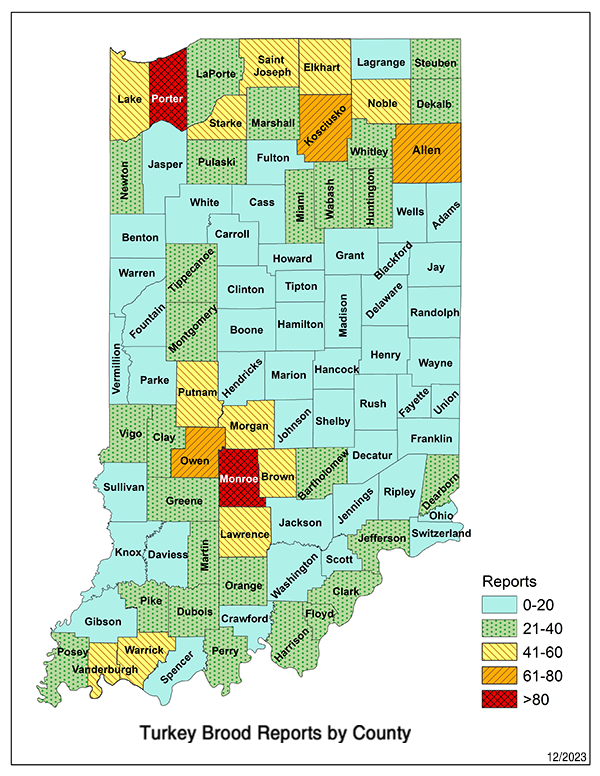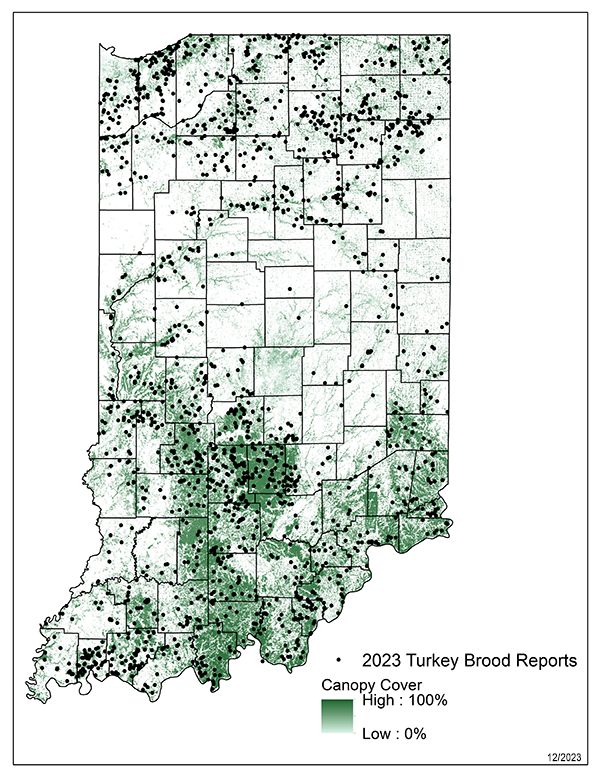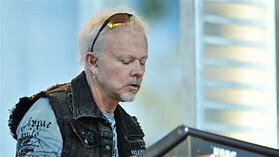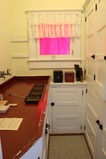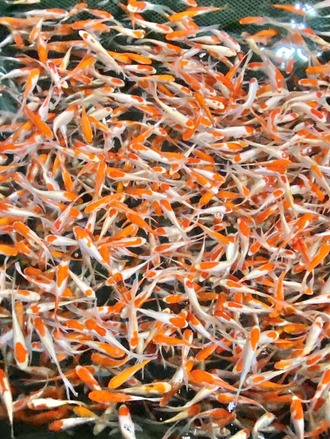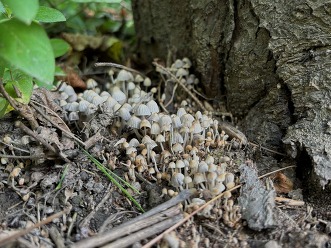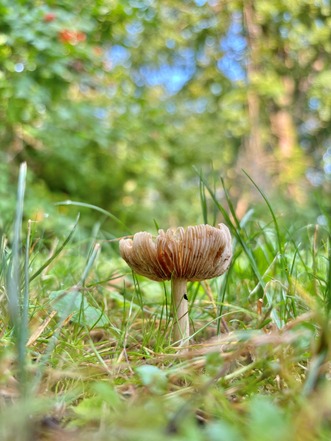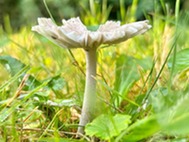
Every May, wild turkey chicks (poults) begin to hatch in Indiana, and DNR needs your help counting turkey broods (hens with poults) and hens without poults.
Brood reports have been collected every year since 1993 to calculate the annual Wild Turkey Production index, which informs biologists about population status and guides management decisions for the species.
Please share your 2024 observations with us online from July 1 until Aug. 31. Recording observations takes less than five minutes, and no login is required.
We rely on your observations to calculate our Production Index, so every report counts! We appreciate your participation.
The wild turkey brood reporting period is July 1 - Aug. 31
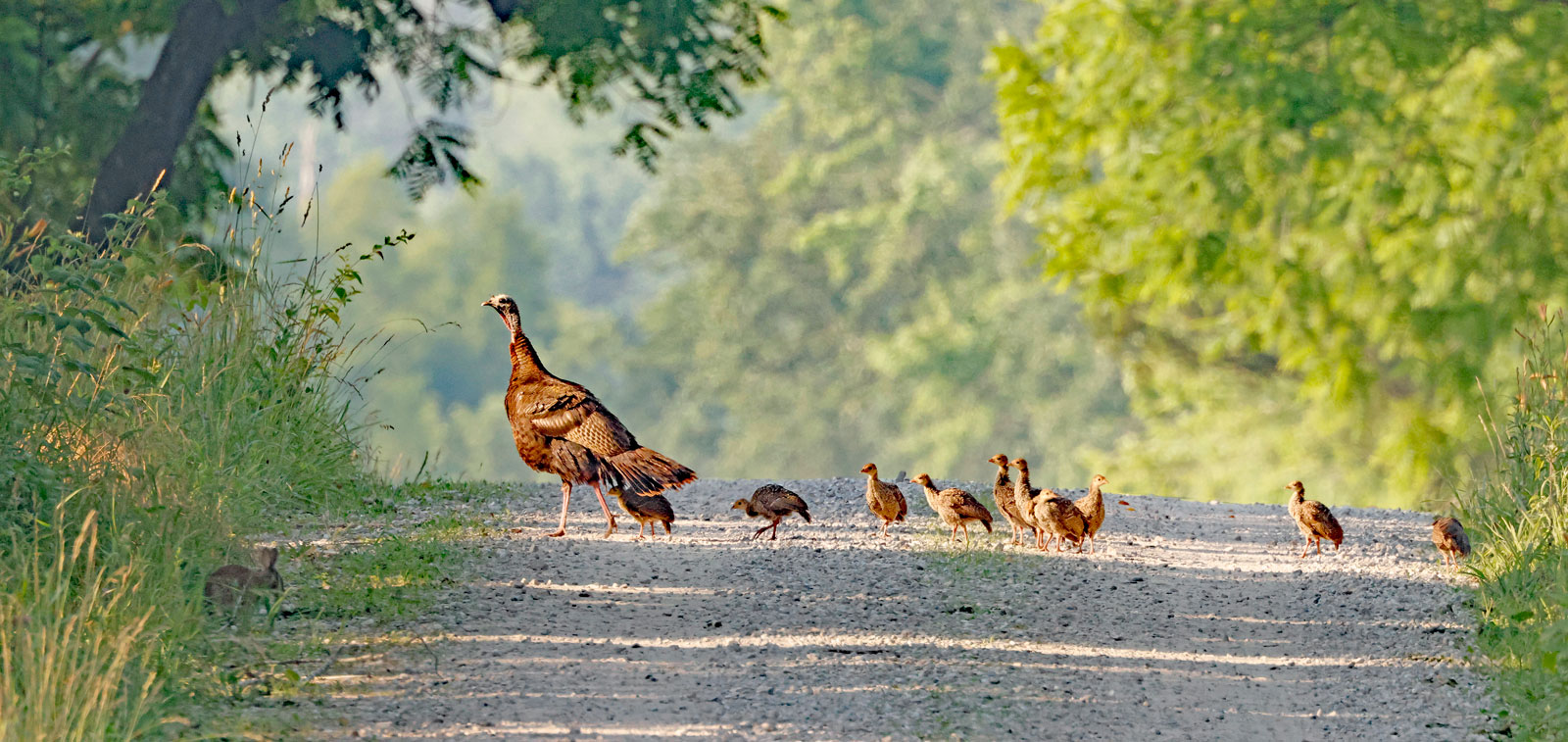
Wild turkey hen with ten poults. Photo by Dan Kaiser.
Help the DNR Division of Fish & Wildlife monitor summer production of wild turkeys by recording wild turkey sightings during July and August using our online survey tool.
Why count turkeys?
Brood surveys provide useful estimates about annual production by wild turkey hens and the survival of poults (young turkeys) through the summer brood-rearing period. Summer brood survival is generally the primary factor influencing wild turkey population trends. Information on summer brood survival is essential for sound turkey management. Information gathered through the brood survey includes:
- Average brood sizes (hens + poults). For example, in the photo above there is one hen with seven poults, for a brood size of eight.
- Percentage of adult hens with poults.
- Production Index (PI) = total number of poults/total number of adult hens
What is a wild turkey brood?
A wild turkey brood is composed of at least one adult hen with young (poults). As the summer progresses, multiple broods may gather into what is termed a “gang” brood with several adult hens and multiple broods of poults of varied ages. During summer, adult gobblers (male turkeys) play no role in raising a brood and either form small male only “bachelor” flocks or are observed as a single gobbler.
No gobblers should be reported.
- 2022 Turkey Brood Report
- 2021 Turkey Brood Report
- 2020 Turkey Brood Report
- 2019 Turkey Brood Report
- 2018 Turkey Brood Report
- 2017 Turkey Brood Report
What should I report if I see a turkey brood or some turkey hens without poults?
We are interested in the following observations of turkeys from across the state:
- Number of adult hens with the number of poults or
- Number of adult hens without poults and
- County and date of each observation.
Please provide as accurate a count of both hens and poults as possible. It is also just as important to record observations of hens without poults. Don’t compile multiple observations as one report, instead report each different observation separately, even if observations of different broods are made on the same day in the same county. Understand that by mid to late August, turkey poults are normally about two-thirds the size of an adult, and a juvenile gobbler (jake) can be about the same size as an adult hen. Suspected repeat observations of the same turkeys during the same month should not be recorded.
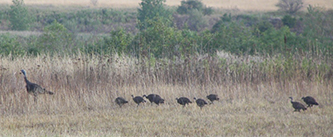
Wild turkey hen with eight poults.
Need help identifying male and female turkeys?
Females are generally smaller in body size, about the size of a Canada Goose (8-12 lbs), and their coloration is duller brown to buff with no obvious iridescence. In general, female wild turkeys do not have a visible beard. In contrast, males have larger bodies, much larger than a Canada Goose (18-28 lbs), and their general coloration is very dark, appearing black with an iridescent sheen. Most adult male wild turkeys have a visible beard.
Turkey Teaser Results
The full brood report will be posted above once it is available. In the meantime, enjoy these maps that show participation by county and brood reports by landcover from the 2023 Turkey Brood Reporting period. If there are no reports from your area, but you saw a turkey brood this past summer, make sure to check back in July and August to submit your own reports and contribute to turkey management.
If you have questions about the turkey brood survey, please email Wildlife Index, at

By Monika Spaulding
With hopes of helping struggling students to reach their full potential, Homestretch is looking for community support as it gets established in Washington County.
Last Thursday evening, the group held a fundraising, informational dinner at Westview Church. During the event, community members heard from the organization’s board about what the group is doing and wants to continue doing in the community.
Maria Burks led the evening, discussing everything from the group’s logo to their mission. She said Homestretch is something that has been on her heart for years, she just wasn’t sure how to get it up and going. That’s when she reached out to others about her vision and the ball started rolling.
The group specifically helps students who are 18 years old, are seniors in high school and do not have a home. She said although those are very specific terms, there is a great need to help students who match those criteria.
“This is a real problem that lives right here in our county,” said Burks. “We have a homeless camp. We have homeless kids.”
She said the goal is to get kids in a home their senior year and help them with life skills, including things like money management. This will allow students to finish high school in a more stable environment, get their high school diploma and be ready for the real world.
Burks said she is someone who wants to find out where God is working already and join there. She has been walking through open doors to make this organization a reality.
“We are in the iron grip of poverty in this area,” she said, adding that there are kids living in sheds, no bed, no water, no electricity.
She said when bad things happen, people seem to ask, “where is God in all of this?”
“God’s weaving a pattern and we all have a part in it,” she said, gesturing to everyone present. She said everyone in attendance has been part of her life in one way or another and bringing everyone together to work on this project is one example of God at work.
Burks reached out to David Miller at Hoosier Uplands about 15 months ago. Her original thought was to have a house where these students could live, but Miller convinced her that it would be too big of an expense and the upkeep, insurance, etc. would be too much. That’s when she turned to the idea of finding host families, people who would be willing to let these students live with them for a school year.
“Sustainability is the key,” said Burks. “Why start something if you can’t keep it going?”
She decided that host families would make the program more sustainable. Often students in this situation are “couch surfers” or kids who go from home-to-home sleeping at friend’s houses, places where they feel comfortable. With Homestretch, those places can become year-long homes for these students.
Hoosier Uplands liked the idea of Homestretch and saw the need, donating $10,000 to get things started, which allowed them to get the 501(c)(3). Burks said after figuring that part out, the question became how can we bring resources to the homes and help them?
Thanks to a fund with the Washington County Community Foundation, the families will receive a $400 stipend every month to help with expenses. They will also give $100 a month to the youth to help with teaching money management. Host families will help get them on their feet, get doctor’s appointments, etc. and give them the care they may not have received in the past.
Burks said WCCF Director Judy Johnson shared with her information she came across that were “rules” to follow to keep yourself out of poverty. The three rules were: graduate from high school, wait to get married until after age 21 and do not have children until you’re married, work a full-time job. Burkes said if these are followed you have a less than 2% chance of living in poverty.
“We want kids to take responsibility for their own life,” said Burks. “Personal decisions trump anything the government will ever do.”
Attendees Thursday evening heard testimonials from West Washington students who were helped by families in the community.
Charles Madden Jr., who was a 7th grader when Burks was the school counselor 10 years ago, was one of the success stories. His dad was arrested at a football game and everyone wanted to make sure Burks talked to him because he’d be so upset. Burks said he was upset, but it was because he didn’t want to blow the good things he had going at school. He was a good kid who didn’t do drugs and alcohol and he wanted to make sure he stayed that way and that he graduated from high school. He needed someone in his corner to support him and his goals.
Madden said coach Phillip Bowsman did a lot of mentoring for him. He got the encouragement and support he needed to graduate. His parents didn’t graduate, making him even more proud of his accomplishment. Now, Madden is getting ready to graduate college from Indiana State in construction management.
“Charles flipped the lens for me,” said Burks. “He was telling me that ‘what I need is support.’”
Another testimonial was a student who didn’t have a place to live or stable environment to grow in. His grades were suffering, and he missed a lot of school. This past school year, he moved in with Coach Jeremy Lowery. He turned his grades from Fs and Ds to As and Bs and only missed one day of school. He graduated and is currently working full time at a factory in Madison.
Robert Chandler is a student who moved in with the Nance family. He said he learned “water can be as thick as blood.
“They were there for me every single day. It has changed my whole life.”
Tracy Smith lost her parents when she was 5 and her sister was 1. They lived with grandparents until she was 17 when her aunt and uncle took over due to the death of her grandparents. It was not a good situation.
She said she met Don and Sherry Elgin through her best friend who was with the Elgin’s all the time. They stepped up and took Smith into their home.
“They were loving and consistent,” she said, adding that two years later, they took her sister in, too. “They gave me a place to be a teen instead of having to grow up too soon.”
These are just a few of the success stories that Homestretch would like to build on in Washington County.
“When we tell people about this, a light comes on in their eyes: they want to give us money or they want a kid,” said Burks.
There is a school committee at West Washington that helps find students who need placement. The committee includes counselors, teachers, coaches and parents. Applications are also on the Homestretch website.
The goal is to get the program going to benefit students at all three county schools.
The organization needs help in many ways and encourages the community to help in whatever way they can: monetarily, providing a home or serving on the organization’s board.
Learn more at homestretch-foundation.org.


Free Legal Assistance for Artists and Small Arts Organizations
Pro Bono Indiana's (IndianaLegalHelp.org) Lawyers for the Arts project provides legal assistance at no cost to artists and small arts organizations. To obtain help, please call 812.402.6303. Calls from artists and small arts organizations are taken on Tuesdays and Thursdays from 9:00 a.m. to 11:00 a.m. (Central Time). Support for this service is provided by the Indiana Bar Foundation.
Grants for Arts Projects: Resources for Applying Organizations
When it comes to grant applications, there are many resources available to organizations looking for tips, especially first-time applicants. The National Endowment for the Arts provides webinars, office hours, application checklists and guides, and more for grant applicants. Learn more about how to apply to National Endowment for the Arts funding opportunities here.
Accessibility in the Arts
Are you an artist with a project, program, or event accessible to the public? Physical and programmatic accessibility is an integral part of the planning and budgeting processes. Ensure that persons with disabilities will be able to participate in your offerings! Learn more about making the arts accessible to all.
Dates and opportunities to keep an eye on:
- (July 29) Arts Midwest Culture Bearers Award Application Deadline
- (July 31) Blu-Sky Artist Award Submission Deadline
- (August 2) Arts Place Portable Cultural Planning Studios Request for Proposal
- (August 15) Dance/USA Fellowships to Artists
- (August 31) Indiana Humanities INCommon Grant Application Deadline
- (September 9) Big Car Collaborative Power Plant Grant Application Deadline
- (September 22) Artist or Consultant Sought for Sculpture "Trail" Project in Martinsville

By Regional Opportunity Initiatives (ROI)
Summer will be gone before we know it, so take advantage of this perfect time to explore the Indiana Uplands. Enjoy summer fun whether you’re underground, on the water, or at a drive-in movie theater. The Uplands offers plenty of activities while the temperatures are warm and the sun is shining!
To help you plan your summer adventures, we’ve created a uniquely Uplands bucket list! Here are some of our favorite spots to visit and enjoy during the summer. We hope you love them as much as we do!
1. Marengo Caves
Feeling hot, hot, hot? Cool off underground in the Uplands at the most visited natural attraction in Indiana: Marengo Caves in Crawford County! This natural gem is perfect for a visit in the summer when the weather is hot as it maintains a year-round temperature of 52 degrees. You can explore the cave all year! How cool is that? In addition to the Crystal Palace and Dripstone Trail cave tours, there are some amazing activities above ground including go-karts and putt-putt golf.
2. Wilstem Wildlife Park
Experience the ultimate thrill when you get up close and personal with majestic wildlife – and ride a zipline or two – at Wilstem Wildlife Park in Orange County! Elephants, sloths, giraffes, and otters – oh my! At Wilstem, you can visit with all these adorable animals and more! Go on a drive-thru safari in your own vehicle or catch a ride on Wilstem’s wagon to see the wildlife out in the open. Ready to go prehistoric? The recently added Dinosaur Safari features animated dinosaurs you can enjoy from your vehicle, too! Looking for more thrills? Ride a zipline or go horseback riding while you’re there! You can plan to spend an entire summer day at Wilstem alone! And maybe walk a way with a one-of-a-kind profile picture, too! Wilstem was recently nominated as one of the best animal encounters in the country by Newsweek. Cast your vote for them by July 31. The top animal encounter will be announced in August!
3. Patoka Lake Wine Cruise
Sipping a glass of wine as you soak in the sunset on a beautiful lake feels like a dream, but in the Indiana Uplands, it is a reality! Patoka Lake Wine Cruises happen all summer long on the Patoka Voyager cruise boat. Sunsets are paired with Indiana wines, d’oeuvres, and desserts. Taste delicious wines and forget about your worries for a while – only in the Uplands! Better hurry and book your spot for the last two cruises set to sail in August. While you’re there check out Patoka Lake Winery and the new Old Homestead Distilling Co. featuring a tasting room, gift shop, spirit slushies, craft cocktails, and distillery tours! There is also a new saloon, brewery, and a 28-room hotel, in case you feel like extending the Patoka Lake fun into the night!
4. Go putt-putting
Ready for a little friendly competition? Grab your crew and head to Hoosier Putt Hole in Monroe County or Freedom Fairway Miniature Golf in Lawrence County for a chance to get a hole-in-one with a side of FUN! These courses are packed with creatively designed obstacles that add an extra layer of excitement to every game. Whether you’re a seasoned pro or a first-time player, you’ll find something to enjoy. Perfect for all ages, a trip around these putt-putt courses promises laughter, fun, and memorable moments with family and friends. So, gather your group and embark on an adventure that blends challenge and amusement, creating unforgettable experiences for everyone!
5. Drive-in movie
Spend a warm summer night watching a movie under the stars in the Uplands! Did you know there are less than 300 drive-in theaters in the United States? Of those theaters, less than 20 are in Indiana! We are lucky in the Uplands to have THREE drive-in movie theaters hosting blockbuster nights under the stars all summer. Embrace nostalgia and enjoy the magic of movies from the comfort of your car by visiting Starlite Drive-In Theater in Monroe County, Holiday Drive-In in Lawrence County, and Cinema 67 Drive-In Theater in Owen County. Don’t forget the popcorn!
SalemLeader.com
Leader Publishing Company of Salem, Inc.
P.O. Box 506
117-119 East Walnut Street
Salem, Indiana. 47167
Phone: 812-883-3281 | Fax: 812-883-4446
Business Hours:
Mondays through Fridays, 9:00am - 5:00pm
News:
news@salemleader.com
Office:
office@salemleader.com
Publisher:
publisher@salemleader.com
Business
- More Business News
- Go To Guide
- Business Directory
- Real Estate
- Auctions
Education
- More Education News
Opinion
- Editorials
- Letters to the Editor
- Columns
- Unsung Heroes
- Days Gone By
- In the Garden
- Guest Columns
- Reader's Poll
- Salem Leader Forum
- Questions and Answers
Church
- Bible Aerobics
- Church News
- Church Directory


